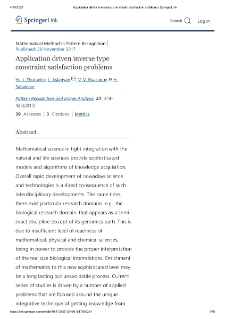Object
Title: Application driven inverse type constraint satisfaction problems
Co-author(s) :
Aslanyan Levon ; Ryazanov Valery ; Sahakyan Hasmik
Abstract:
Mathematical science in tight integration with the natural and life sciences provide sophisticated models and algorithms of knowledge acquisition. Overall rapid development of nowadays science and technologies is a direct consequence of such interdisciplinary developments. The same time, there exist particular research domains, e.g., the biological research domain, that appears as a semi-exact discipline (except of its genomics part). This is due to insufficient level of readiness of mathematical, physical and chemical sciences, being in power to provide the proper interpretation of the real size biological interrelations. Enrichment of mathematics to this new sophisticated level may be a long lasting but unavoidable process. Current series of studies is driven by a number of applied problems that are focused around the unique integrative technique of getting knowledge from fragmented data and descriptions. A large number of links connect these ideas to the problems of: artificial intelligence, intelligent information management, high performance computation, and other research domains. Our objective is in provision of integrated solutions of inverse type combinatorial problems that will help to sustain a set of applied problems. The base set of applied problems we consider involves the radiation therapy planning, the wireless sensor network integrated-connectivity-coverage protocols with its decentralized management, and the network tomography scenario devoted to the issue of energy minimization in networks. As we will see the necessary mathematical technique of solving these problems is focused around the model description by the sets of constraints and relations, by integration of the partial knowledge about these models. Two scenarios have been considered. One is based on the use of projections and their interpretation, and the second is based on the local neighbourhood analysis (generic projections). Given projections and/or neighbourhoods (in inverse manner), it is to analyse the consistency issue; to know the properties of the set of solutions; and to reconstruct one or all solutions of these problems. In mathematical level the problem is related to the well-known open problems such as the Berge’s hypothesis about the simple hypergraphic degree sequences. The technique to be used in investigations involves Boolean domain studies and the n-cube geometry, Lagrangean relaxation together with integer linear programming, Minkowski geometry, Voronoi diagrams, and the Constraint satisfaction mathematics. Prototype solutions and demonstrations to the mentioned applied problems will be provided.
Publisher:
Date accepted:
Date of publication:
Identifier:
oai:noad.sci.am:136155
DOI:
ISSN:
Language:
Journal or Publication Title:
Pattern Recognition and Image Analysis
Volume:
Number:
URL:
Affiliation:
Dorodnicyn Computing Centre, Federal Research Centre “Informatics and Control” of RAS, 119333, Moscow ; Institute for Informatics and Automation Problems
Country:
Indexing:
Object collections:
- Digital Library > Academic Insitutions > Insitute for Informatics and Automation Problems of NAS RA > Publications
Last modified:
Apr 19, 2021
In our library since:
Apr 19, 2021
Number of object content hits:
170
All available object's versions:
https://noad.sci.am/publication/149405
Show description in RDF format:
Show description in OAI-PMH format:
| Edition name | Date |
|---|---|
| Yu. I. Zhuravlev, Application driven inverse type constraint satisfaction problems | Apr 19, 2021 |





